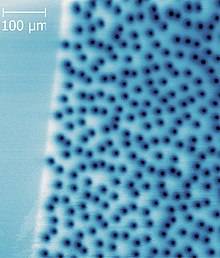
Back Vòrtex quàntic Catalan מערבולת קוונטית HE 量子渦 Japanese 양자 소용돌이 Korean Kvantisert virvel NN Квантовый вихрь Russian Квантовий вихор Ukrainian

In physics, a quantum vortex represents a quantized flux circulation of some physical quantity. In most cases, quantum vortices are a type of topological defect exhibited in superfluids and superconductors. The existence of quantum vortices was first predicted by Lars Onsager in 1949 in connection with superfluid helium.[2] Onsager reasoned that quantisation of vorticity is a direct consequence of the existence of a superfluid order parameter as a spatially continuous wavefunction. Onsager also pointed out that quantum vortices describe the circulation of superfluid and conjectured that their excitations are responsible for superfluid phase transitions. These ideas of Onsager were further developed by Richard Feynman in 1955[3] and in 1957 were applied to describe the magnetic phase diagram of type-II superconductors by Alexei Alexeyevich Abrikosov.[4] In 1935 Fritz London published a very closely related work on magnetic flux quantization in superconductors. London's fluxoid can also be viewed as a quantum vortex.
Quantum vortices are observed experimentally in type-II superconductors (the Abrikosov vortex), liquid helium, and atomic gases[5] (see Bose–Einstein condensate), as well as in photon fields (optical vortex) and exciton-polariton superfluids.
In a superfluid, a quantum vortex "carries" quantized orbital angular momentum, thus allowing the superfluid to rotate; in a superconductor, the vortex carries quantized magnetic flux.
The term "quantum vortex" is also used in the study of few body problems.[6][7] Under the de Broglie–Bohm theory, it is possible to derive a "velocity field" from the wave function. In this context, quantum vortices are zeros on the wave function, around which this velocity field has a solenoidal shape, similar to that of irrotational vortex on potential flows of traditional fluid dynamics.
- ^ Wells, Frederick S.; Pan, Alexey V.; Wang, X. Renshaw; Fedoseev, Sergey A.; Hilgenkamp, Hans (2015). "Analysis of low-field isotropic vortex glass containing vortex groups in YBa2Cu3O7−x thin films visualized by scanning SQUID microscopy". Scientific Reports. 5: 8677. arXiv:1807.06746. Bibcode:2015NatSR...5E8677W. doi:10.1038/srep08677. PMC 4345321. PMID 25728772.
- ^ Onsager, L. (1949). "Statistical Hydrodynamics". Il Nuovo Cimento. 6(Suppl 2) (2): 279–287. Bibcode:1949NCim....6S.279O. doi:10.1007/BF02780991. ISSN 1827-6121. S2CID 186224016.
- ^ Feynman, R. P. (1955). "Application of quantum mechanics to liquid helium". Progress in Low Temperature Physics. 1: 17–53. doi:10.1016/S0079-6417(08)60077-3. ISBN 978-0-444-53307-4.
- ^ Abrikosov, A. A. (1957) "On the Magnetic properties of superconductors of the second group", Sov. Phys. JETP 5:1174–1182 and Zh. Eksp. Teor. Fiz. 32:1442–1452.
- ^ Matthews, M. R.; Anderson, B. P.; Haljan, P. C.; Hall, D. S; Wieman, C. E.; Cornell, E. A. (1999). "Vortices in a Bose-Einstein Condensate". Physical Review Letters. 83 (13): 2498–2501. arXiv:cond-mat/9908209. Bibcode:1999PhRvL..83.2498M. doi:10.1103/PhysRevLett.83.2498. S2CID 535347.
- ^ Macek, J. H.; Sternberg, J. B.; Ovchinnikov, S. Y.; Briggs, J. S. (2010-01-20). "Theory of Deep Minima in $(e,2e)$ Measurements of Triply Differential Cross Sections". Physical Review Letters. 104 (3): 033201. Bibcode:2010PhRvL.104c3201M. doi:10.1103/PhysRevLett.104.033201. PMID 20366640.
- ^ Navarrete, F; Picca, R Della; Fiol, J; Barrachina, R O (2013). "Vortices in ionization collisions by positron impact". Journal of Physics B: Atomic, Molecular and Optical Physics. 46 (11): 115203. arXiv:1302.4357. Bibcode:2013JPhB...46k5203N. doi:10.1088/0953-4075/46/11/115203. hdl:11336/11099. S2CID 119277044.
© MMXXIII Rich X Search. We shall prevail. All rights reserved. Rich X Search